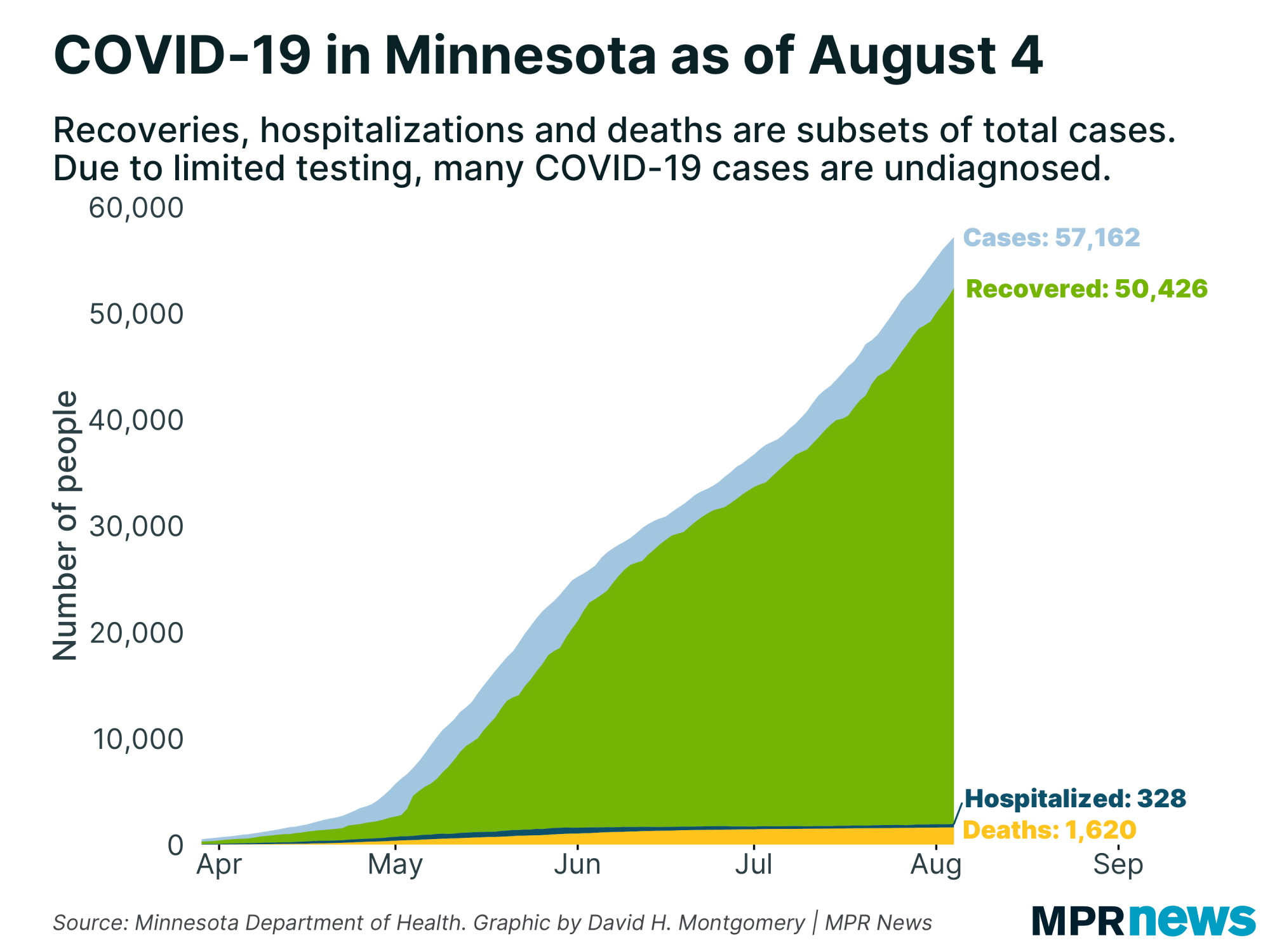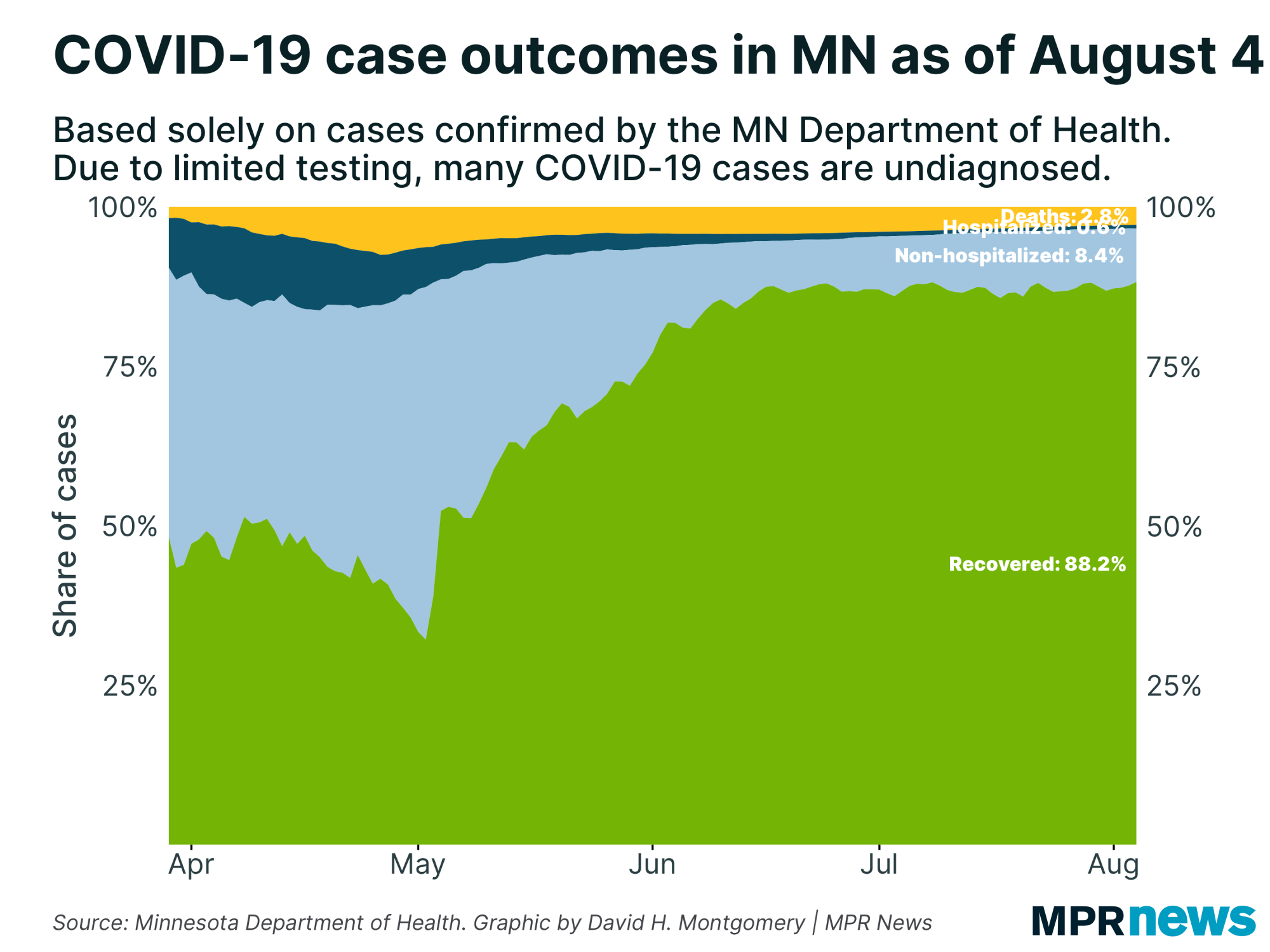Latest on COVID-19 in MN: 1,115 deaths; hospitalizations, ICU cases down

Go Deeper.
Create an account or log in to save stories.
Like this?
Thanks for liking this story! We have added it to a list of your favorite stories.
Updated 11:16 a.m.
Minnesota’s COVID-19 toll continued its steady climb, reaching 1,115 deaths on Thursday, 29 more than the prior day.
However, the number of people currently hospitalized and needing intensive care both fell. Current hospitalizations were at 512, down 25 from Wednesday while the number of intensive care patients fell by 10, to 244.
Hospitalizations and intensive care needs are key metrics officials examine as they try to manage the spread of the disease so it does not overwhelm the health care system. Current ICU cases are at their lowest point in a week. The number of people hospitalized with COVID-19 but not in intensive care is at its lowest point in three weeks.
The state’s confirmed 26,273 cases since the pandemic began. More than 80 percent of those infected have recovered to the point they no longer need to be isolated. Among those who’ve died, most were living in long-term care and had nearly all of them had underlying health problems.
Turn Up Your Support
MPR News helps you turn down the noise and build shared understanding. Turn up your support for this public resource and keep trusted journalism accessible to all.

The newest numbers come as Minnesota’s top health officials remain concerned that protests tied to the killing of George Floyd are inadvertently helping spread COVID-19.
Minnesota Health Commissioner Jan Malcolm says her department has made clear to providers around the state that people involved in demonstrations over George Floyd’s killing, or any following cleanup efforts should be tested for COVID-19 — even if they have no symptoms.
She urged people to get tested right away if they have symptoms. If they don’t, she said, they should wait five to seven days after they participated in a protest or cleanup effort to get tested.
And if their test result is negative, but they suspect they were exposed, Malcolm encouraged people to get retested around 12 days after they think they were exposed.
The demonstrations are “a recipe for spread" of the disease, Malcolm said Wednesday. "The mitigating factor is that it was outdoors."
“We’re still at a fairly high degree of community spread in Minnesota,” she said.

Still, Malcolm said that there are some signs the state’s cases are stabilizing. For instance, the number of overall hospitalizations for COVID-19 is on a downward trend, and the number of people in intensive care unit beds has been holding steady at around 250.
Malcolm added that the state should start to see the impact of the state’s efforts to reopen in about a week.
The fact that people without symptoms of the illness can still be spreading the virus continues to be among the biggest challenges, said Kris Ehresmann, the state’s infectious disease director.
“There is a big role for asymptomatic transmission,” and it’s hard to identify who those people are, she said.
Meatpacking hot spots remain
Many of the outbreaks outside the Twin Cities metro area are focused around meatpacking plants. Officials have intensified testing in those hot spots, uncovering more infections.
In southwestern Minnesota’s Nobles County, where an outbreak hit Worthington’s massive JBS pork plant, about 1 in 15 people have tested positive for COVID-19. In mid-April, there were just a handful of cases. By Thursdsay, there were 1,562 confirmed cases, although the numbers are rising at a much slower rate than in previous weeks.
The JBS plant shut on April 20 but has since partially reopened with expanded hygiene and health monitoring measures.
Similar problems have been reported in Stearns County, where COVID-19 cases tied to two packing plants — Pilgrim’s Pride poultry plant in Cold Spring and Jennie-O Turkey in Melrose — skyrocketed in May.
An undisclosed number of workers at both plants have tested positive for the virus. There were about 55 confirmed cases in Stearns County in early May. By Wednesday, confirmed cases were at 2,050 with 14 deaths.
Kandiyohi County in west-central Minnesota is also seeing cases continue to climb more than a month after officials with the Jennie-O turkey processing plant there said some employees had tested positive for the coronavirus. The county had confirmed three COVID-19 cases then.
On Thursday, the Health Department reported 511 people have now tested positive in the county.
While the counts in those counties are high relative to their population, officials say the growth in new cases in those areas appears to be stabilizing.
Mower County in southern Minnesota, another county with a large meatpacking presence, is becoming a hot spot.

Mower County has jumped the past few weeks, reporting a total of 406 positive COVID-19 cases now with two deaths. The Rochester, Minn., Post-Bulletin reports two meat plants in Austin, Minn., are seeing COVID-19 cases rise rapidly.
Developments from around the state
Beware of contact-tracing scams, MN officials warn
The state is warning Minnesotans to be on alert for text scams related to contact tracing of COVID-19.
According to the Federal Trade Commission, scammers are targeting people via text, saying that someone they know has tested positive for coronavirus and that they should click on a link for more information.
Some texts ask people to download software on to their phone, while others seek information like Social Security numbers and banking information.
Contact tracing is the practice of figuring out who someone who has tested positive for coronavirus has been in contact with. It's a strategy meant to mitigate the spread of the virus.
The state is encouraging people who get these texts to report them to the FBI.
— Catharine Richert | MPR News
U of M study: Hydroxychloroquine can’t prevent coronavirus infection
A new University of Minnesota study shows hydroxychloroquine is not able to prevent the development of COVID-19 better than a placebo.
The results of the first randomized clinical trial of the drug will be published in the New England Journal of Medicine. Researchers also found that 40 percent of the trial participants taking hydroxychloroquine developed nonserious side effects like nausea and diarrhea.
However, the trial found no cardiac complications from taking the drug, which is typically used for lupus.
The trial included 821 people in the United States and in Canada who had been exposed to someone with the virus, either members of their household or in their work as a health care worker or first responder.
President Donald Trump has touted the drug as a treatment for coronavirus, despite warnings from medical professionals that there was no research to back up his claims.
— Catharine Richert | MPR News
Questions over how MN defines congregate care
Data from the Centers for Medicare and Medicaid Services confirms that Minnesota is using a broad definition of long-term care, including foster care and hospice. That’s creating some confusion as people try to compare Minnesota’s COVID-19 deaths to other states.
Most states are only reporting the deaths of people in nursing home facilities as congregate care deaths.
State legislators have criticized public health officials for what appears to be a high number of long-term care deaths relative to other states. Minnesota’s reported about 80 percent of all COVID-19 related deaths have been associated with these facilities.
But it’s a statistical anomaly — the state’s more expansive definition has actually skewed that statistic, said Health Commissioner Jan Malcolm.
"The narrative that's emerged is not accurate. That's not to say there aren't real important issues about are we doing as well as we can, and how we can do better,” she said during a recent state legislative hearing.
The national average of nursing home deaths is 27 per 1,000 residents, while Minnesota's is 12 deaths per 1,000.
Minnesota’s nursing home resident cases are also below the national average.
State Sen. Sen. Karin Housley, R-St. Marys Point, has also demanded answers from the state on why people who have coronavirus are being allowed back to their long-term care facilities.
Most of the spread, however, has occurred when staff brings the virus to these facilities, not from residents, said Kris Ehresmann, the state’s infectious disease director.
Housley used the Senate hearing to push for universal testing in long-term care, saying she will introduce a new bill aimed at universal testing in these facilities. She wants to use some state money meant to fight COVID-19 to make sure all staff and residents in places like nursing homes and assisted living are tested for free, and regularly.
“Just get me universal testing. Let me see my mom. Let my mom have her hairdresser come in and do her hair,” she said. “We're talking about getting families back with their loved ones.”
Malcolm says the state’s goal is testing in facilities that have no cases, but is currently focusing efforts on facilities that have at least one.
— Catharine Richert | MPR News
COVID-19 in Minnesota
Data in these graphs are based off Minnesota Department of Health cumulative totals released at 11 a.m. daily. You can find more detailed statistics on COVID-19 at the Health Department website.
The coronavirus is transmitted through respiratory droplets, coughs and sneezes, similar to the way the flu can spread.
Government and medical leaders are urging people to wash their hands frequently and well, refrain from touching their faces, cover their coughs, disinfect surfaces and avoid large crowds, all in an effort to curb the virus’ rapid spread.


